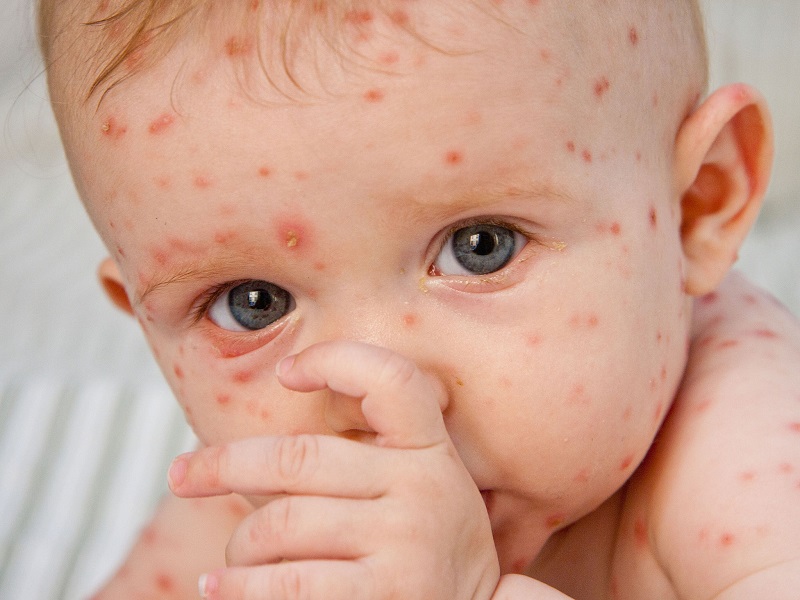Also called varicella, chickenpox is a viral infection caused by the varicella-zoster virus. It spreads when an infected person sneezes or coughs. It commonly affects children under 10; in fact, 90% of adults are immune to this virus because they have already had an episode of chickenpox in their childhood. However, many people still don't know much about it and want to know what chickenpox looks like. No hurry. Let's find out more about it.

What Does Chickenpox Look Like?
The most common symptom of chickenpox is a red rash that may be made up of blisters or spots.
You may not experience any symptoms for 1-3 weeks after your exposure to the virus.
Some symptoms may appear before the rash. You may have a headache, feel sick, and feel generally unwell.
Some people also have a high temperature of 100.4°F or over.
Loss of appetite and aching, painful muscles are also common, but they usually affect adults or older children with chickenpox.
What does chickenpox look like? The answer is not complete without knowing the how chickenpox rash looks like. This rash may take some time to develop. It actually appears in three stages. For instance:
You will notice raised red spots in the beginning. These spots usually appear on the trunk or face before affecting other parts of the body. There may be only a few spots on the body or there may be so many of them. It is possible to have those spots on the soles of the feet, on the palms of the hands, around the genitals, or inside the mouth or ears.
Within a day, these spots turn into fluid-filled blisters, which can be very itchy. It is important to avoid scratching them because this could cause the infection to spread to other parts of the body. This also increases risk of having a more serious skin infection.
In a few days, those blisters finally turn cloudy and begin to dry out. Those spots may scab over, but new ones may appear at the same time. It means that you may have a mix of blisters, spots, and scabs on your body.
It is important to keep in mind that this viral infection is very contagious and stays contagious until there are some fluid-filled blisters. However, those blisters usually scab over in 5-6 days after the rash started.
Know the Complications of Chickenpox
What does chickenpox look like? You already know the answer, but you should also learn about the complications associated with this condition. While it does not always lead to complications, it can sometimes be very serious and cause complications in high-risk people. Some common complications are:
Dehydration
Toxic shock syndrome
Pneumonia
Reye's syndrome
Inflammation of the brain
Bacterial infections of the bones, soft tissues, skin, or bloodstream
How to Deal With Chickenpox at Home
Do Not Let It Spread
Chickenpox is a viral infection and can spread easily. Therefore, it is important to know how it spreads to ensure you do not let others suffer with you or your child. The infection can be transmitted by direct contact with the blisters, mucus, or saliva of an infection person. It can also transmit through the air by sneezing and coughing. Dry and crusted blisters are no longer infected though.
Avoid Scratching
You should never scratch those blisters no matter how itchy they feel. Scratching increases your risk of infection and also results in slow healing and scarring. You should take special care when your child has chickenpox. It may help to put gloves on their hands to ensure they do not scratch those blister, especially at night.
Try Ways to Relieve the Itch
It is obvious for your child to feel miserable when they have headache, fever, and fatigue with blisters that are very itchy. Here are a few tips to relieve the itch:
Add uncooked oatmeal, baking soda, or colloidal oatmeal to bathwater and let your child soak in it for some time.
Make use of calamine lotion and apply it on the spots with care.
Stick to a bland diet if your child has sores on their mouth.
Talk to your doctor and give antihistamines to your child to deal with itching.
Opt for ibuprofen or acetaminophen to treat a mild fever. Never give aspirin to your child.
Keep Your Child Cool
Since you have known, "What does chickenpox look like?" you should take steps to cool those areas affected by it because you need to understand that the skin affected by chickenpox is likely to get hot and the fever is only going to make things worse. It is therefore important to protect your child from humid or hot locations because this can make itching worse. You should stay at home and ensure that your child is in a cool temperature. It is equally important to ensure that someone with chickenpox is not engaging in activities that increase body temperature.
Talk to Your Doctor
If you have taken some homecare measures but they have not offered any relief, you should go talk to your doctor. If your child has a high fever (over 102°F) and it lasts for more than 4 days, see your doctor immediately. It is also important to see a healthcare provider if you develop a serious rash that is near your eyes or oozes pus. You should also seek medical attention if someone with chickenpox has a hard time walking or waking up, becomes confused, has a severe cough, has a stiff neck, or has difficulty breathing. Your doctor will check your symptoms and see if your symptoms are due to a bacterial infection, a severe form of chickenpox or another type of virus.






View All Comments /Add Comment